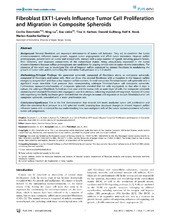| dc.description.abstract | Background: Stromal fibroblasts are important determinants of tumor cell behavior. They act to condition the tumor microenvironment, influence tumor growth, support tumor angiogenesis and affect tumor metastasis. Heparan sulfate proteoglycans, present both on tumor and stromal cells, interact with a large number of ligands including growth factors, their receptors, and structural components of the extracellular matrix. Being ubiquitously expressed in the tumor microenvironment heparan sulfate proteoglycans are candidates for playing central roles in tumor-stroma interactions. The objective of this work was to investigate the role of heparan sulfate expressed by stromal fibroblasts in modulating the growth of tumor cells and in controlling the interstitial fluid pressure in a 3-D model. Methodology/Principal Findings: We generated spheroids composed of fibroblasts alone, or composite spheroids, composed of fibroblasts and tumor cells. Here we show that stromal fibroblasts with a mutation in the heparan sulfate elongating enzyme Ext1 and thus a low heparan sulfate content, formed composite fibroblast/tumor cell spheroids with a significant lower interstitial fluid pressure than corresponding wild-type fibroblast/tumor cell composite spheroids. Furthermore, immunohistochemistry of composite spheroids revealed that the cells segregated, so that after 6 days in culture, the wild-type fibroblasts formed an inner core and the tumor cells an outer layer of cells. For composite spheroids containing Ext1-mutated fibroblasts this segregation was less obvious, indicating impaired cell migration. Analysis of tumor cells expressing the firefly luciferase gene revealed that the changes in tumor cell migration in mutant fibroblast/tumor cell composite spheroids coincided with a lower proliferation rate. Conclusions/Significance: This is the first demonstration that stromal Ext1-levels modulate tumor cell proliferation and affect the interstitial fluid pressure in a 3-D spheroid model. Learning how structural changes in stromal heparan sulfate influence tumor cells is essential for our understanding how non-malignant cells of the tumor microenvironment influence tumor cell progression. | en_US |

